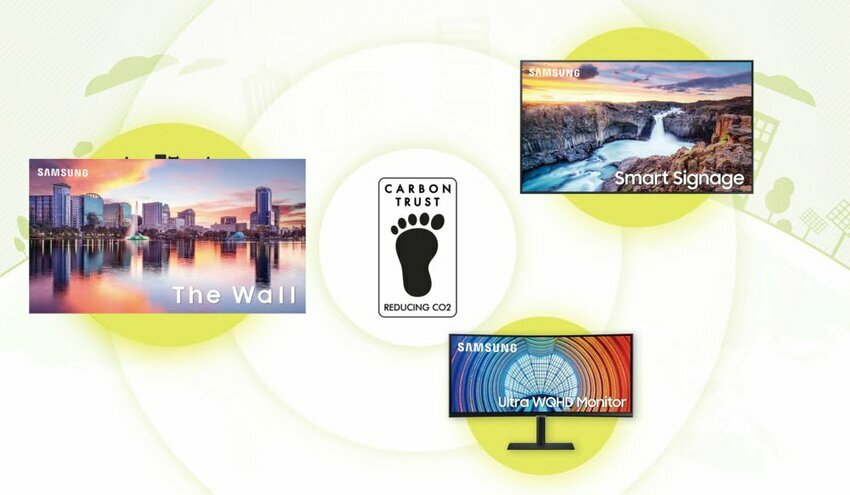 (Credit: Samsung Electronics)
(Credit: Samsung Electronics)Samsung Electronics is a South Korean multinational that makes electronics — everything from mobile phones to appliances to televisions. Specifically, it is the world’s largest information technology company and chipmaker, measured by revenues. At the end of 2020, it had 268,000 employees and 230 worldwide operating hubs. It says that an investment in sustainability will pay huge dividends in the future. Samsung renewable energy commitments include being completely powered by renewable energy.
“As part of our efforts to tackle climate change, we are proud to report that from 2020, all of our worksites in the United States, Europe, and China were 100% powered by renewable energy sources. We plan to build on this success by expanding our renewable energy use in other regions,” says Samsung Electronics Co., Ltd. Vice Chairman and CEO Kim, Kinam.
To that end, it has cut the number of carbon emissions from the memory manufacturing business by 2,529,411 tons and 212,881 because it uses less power.
Furthermore, it says that in 2020, it used 25,000 tons of recycled plastic and will continue to expand its usage. It says 100% of the paper used for product packaging is made from either recycled papers or papers certified by the Forest Stewardship Council for sustainable sourcing. It has reduced the use of plastics by 20% by improving its packaging design.
The goal is to leave behind a small footprint beginning with product development and raw material procurement. But it extends into production, manufacturing, and distribution before it goes to usage and waste disposal. It has launched several reductions, reuse, and recycling initiatives to support the circular economy.
— Samsung minimizes resource and energy use in product planning by expanding the use of sustainable resources, such as recycled raw materials,
— It establishes e-waste take-back programs in different countries while also extracting and reusing materials from waste products,
— It supports suppliers in their effort to reduce greenhouse gas emissions and expand usage of their renewable energy, and
— It uses sustainable packaging materials such as recycled paper. It also minimizes the amount and weight of product packaging.
Indeed, climate change is a priority and could risk every aspect of its business — from its products and services to its manufacturing processes and supply chain. Even its research and development, and sales are threatened. As a result, it has developed energy-efficient products while working hard to reduce GHG emissions.
“In the short term, we consider carbon prices (prices of carbon credit), extreme weather, and adoption of highly-efficient technology as potential issues, while we see securing carbon credit and saving energy cost as opportunities,” the sustainability statement says. “In the mid-term, we expect changes in consumption patterns and an increase in the use of renewable energy to be opportunities while we perceive physical changes such as the rise in temperature as a long-term risk.
In 2020, Samsung implemented 540 greenhouse gas reduction projects, including upgrading high-efficiency equipment and streamlining manufacturing processes. It reduced those emissions by 7,091 tons compared to the expected emission amount. However, it is an increase of 39% compared to the GHG reduction achieved in 2019.
Specifically, Samsung increased its use of renewable energy from 2019 to 2020 by 39%. It raised its use of high-efficiency equipment by 18% and improved its manufacturing processes by 10%, all in that time frame. Furthermore, it says it is reducing its use of LNG usage by using cooling water systems and heat exchangers to recapture wasted heat.
In 2018, Samsung committed to running its worksites in the United States, Europe, and China by 2020 using 100% renewable energy. It has achieved that by installing onsite solar power, purchasing renewable energy certificates, and entering into power purchase agreements. "These efforts led to a three-fold increase of renewable energy usage in 2020 compared to 2018.”
Samsung’s GHC emission target for 2020 was "1.55 tonnes of CO2e/KRW 100 million, which was a 70% reduction from 5.17 tonnes of CO2e/KRW 100 million in 2008. In 2020, it increased its GHG emissions compared to 2019, because it expanded its semiconductor production line and output.
Our GHG emission target for 2020 was 1.55 tonnes of CO2e/KRW 100 million, which was a 70% reduction from 5.17 tonnes of CO2e/KRW 100 million in 2008. In 2020, we saw an increase in GHG emissions compared to 2019, as we expanded the operation of our new semiconductor.
Samsung uses recycled plastics in various product lines, including refrigerators, washing machines, air conditioners, televisions, monitors, and mobile chargers.
It uses 31,000 tons of recycled plastics annually. Since 2009, it has used 276,000 tons. Between 2021 and 2030, it expects to use 250,000 tons.
It replaces product packaging with paper and recycled materials from plastics and vinyl. It will make smaller, lighter packages, reducing pollution tied to transporting those goods. For example, the Galaxy S21 packaging (mobile phone) is 4% plastic by weight. That is 51% less than the Galaxy S7. “We aim to improve the structure of packaging materials in semiconductors to make them easier to recycle and re-use, and to replace packaging materials in all products with sustainable materials.”
It supports the circular economy by taking back and recycling e-waste in 55 countries. The collected e-waste is used as raw materials for metals and plastics. And the plastics are reused in other products. Between 2009 and 2020, Samsung says it collected a total of 4.54 million tons of e-waste, which has increased continuously over the past three years. It has reused 3,366 tons of recycled plastics collected from e-waste in product manufacturing. “Through these efforts, we have reduced the amount of plastic waste and the use of petrochemical raw materials needed to manufacture new products.”
In 2020, the company said it recycled 95% of its waste, helping it reduce what it sends to landfills.